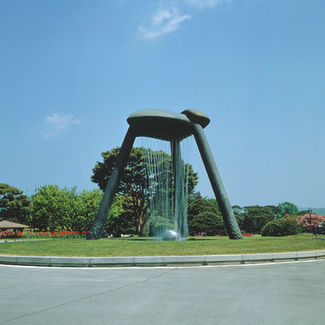
SEKINE Nobuo
SEKINE Nobuo 세키네 노부오
Sekine Nobuo (1942–2019) was a central figure in Japan’s Mono-ha movement, a pivotal contemporary art movement that explored the relationships between materials, space, and time. His work investigates the existence and meaning of objects in relation to the world, inviting viewers to reconsider their perception of materials, space, and human interaction.
Sekine approached ordinary objects, natural elements, and industrial materials in ways that revealed their inherent properties while simultaneously highlighting the human actions involved in engaging with them. His practice emphasized transformation, repetition, and restoration, allowing materials to express their potential for change and continuity. Through this, his work extended beyond formal experimentation to pose existential and philosophical questions about the nature of being and perception.
He introduced the Mono-ha movement to international audiences through numerous exhibitions, and his work is held in prominent collections worldwide, including the Hakone Open-Air Museum, the Museum of Contemporary Art Tokyo, the Hiroshima City Museum of Contemporary Art, the Louisiana Museum of Modern Art in Denmark, and the National Museum of Art, Osaka. Sekine’s practice remains a milestone in Japanese contemporary art, demonstrating how material, space, and human perception can be interwoven into profound aesthetic and conceptual experiences.
Sekine Nobuo was born in 1942 in Saitama Prefecture, Japan, and graduated from the Department of Painting at Tama Art University in 1968. In the same year, he participated in the 1st Contemporary Sculpture Exhibition in Kobe, marking the beginning of his influential contribution to the Mono-ha movement. He later represented Japan at the Venice Biennale in 1970 and held international exhibitions in Europe and North America, including the exhibition at Pyo gallery and in Cologne, Denmark, the Netherlands, and Norway. He also exhibited in Taiwan in 2019, showcasing his recent work.
세키네 노부오(1942–2019)는 일본 현대미술사에서 빼놓을 수 없는 전환점을 마련한 인물로, ‘모노하(Mono-ha)’ 운동의 중심에 섰다. 모노하는 단순한 미술 사조가 아니라, 물질과 공간, 시간이라는 기본적 요소가 어떻게 서로 관계를 맺고, 그 속에서 인간의 인식이 어떤 방식으로 작동하는지를 탐구한 근본적 시도였다. 세키네는 이러한 사유를 실천하는 과정에서, 작품을 단순히 ‘조형물’로 보지 않고, 물질이 지닌 잠재성을 드러내고 세계 속에서 스스로 발화하게 하는 장(場)으로 재구성했다.
그의 대표작에서 드러나듯, 세키네는 자연의 흙, 돌, 금속과 같은 기본적 요소들을 공간 속에서 배치하고, 인위적 개입과 자연적 질서를 동시에 포착했다. 여기서 중요한 것은 무엇을 만들었는가가 아니라 그것이 세계 속에 어떻게 존재하며 의미를 생산하는가였다. 물질의 성질과 중량감, 시간에 따른 변화는 모두 그의 작품의 일부였으며, 이는 단순한 조형 실험을 넘어 “존재란 무엇인가”라는 근본적인 물음으로 귀결된다.
또한 그는 반복과 순환의 개념을 작업 전반에 걸쳐 활용했다. 동일한 매체가 환경이나 맥락에 따라 다른 경험을 불러일으킨다는 점에 주목하며, 물질과 공간의 관계를 매번 새롭게 변형하고 재구성했다. 이로써 세키네의 예술은 인간이 세계를 인식하는 과정 자체를 드러내는 철학적 실천이자 미학적 탐구로 확장되었다.
세키네 노부오의 작품은 단지 일본적 맥락에 머물지 않고, 세계 미술의 흐름 속에서도 중요한 참조점을 형성했다. 그는 다양한 국제전과 비엔날레를 통해 모노하 운동을 알렸고, 그 결과 일본 현대미술이 서구적 미니멀리즘이나 개념미술과 동등하게 대화할 수 있는 지점을 만들어냈다. 그의 작업은 하코네 조각의 숲 미술관, 도쿄도 현대미술관, 히로시마시 현대미술관, 덴마크 루이지애나 현대미술관, 일본 국립국제미술관 등 주요 기관에 소장되어 있으며, 이는 그가 구축한 담론이 전지구적 공감대를 이루었음을 보여준다.
SELECTED WORKS






















